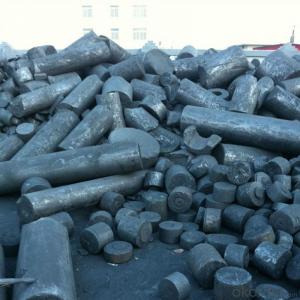Graphite Electrode Scrap high-purity as carbon additive and carburant
- Loading Port:
- Qingdao
- Payment Terms:
- TT OR LC
- Min Order Qty:
- 10 m.t
- Supply Capability:
- 5000000 m.t/month
OKorder Service Pledge
Quality Product, Order Online Tracking, Timely Delivery
OKorder Financial Service
Credit Rating, Credit Services, Credit Purchasing
You Might Also Like
Specifications:
F.C 98%min and 98.5%min, size: 100mm up
- Description & Application
Electrode block processing of carburant in steelmaking and casting, than ordinary recarburizer absorption rate is high, easy to melt, can efficiently improve the quality of products and reduce the cost.
- Technical Specification
F.C (min) |
| 98% |
S (max) |
| 0.05% |
ASH (max) |
| 1.00% |
Vm (max) |
| 1.00% |
H2O (max) |
| 0.50% |
SIZE |
| |
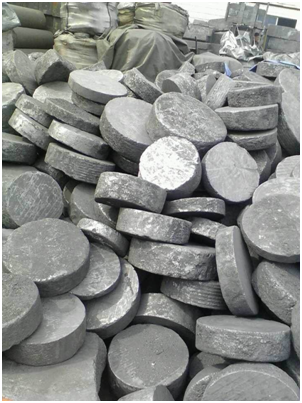
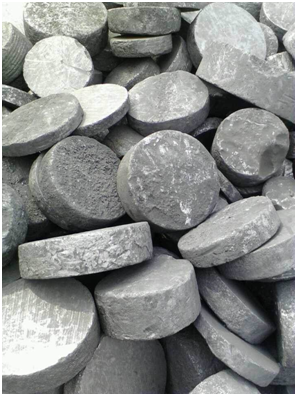
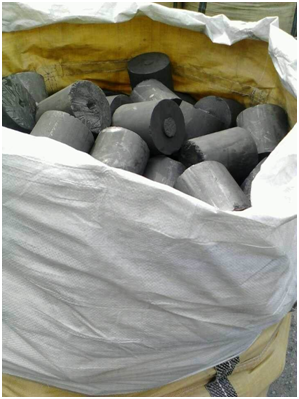
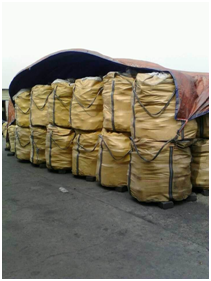
- Q:How is carbon dating used to determine the age of fossils?
- Carbon dating is a scientific method that scientists use to figure out how old fossils and other organic materials are. It works because there is a special type of carbon called carbon-14 that is in the air and gets absorbed by living things when they're alive. When an organism dies, it stops taking in carbon-14 and the amount of it starts to go down over time as it breaks down. To find out the age of a fossil using carbon dating, scientists first take a small piece of the fossil. They then treat this piece with chemicals to get rid of any impurities and get the carbon out of the organic material. The carbon that is extracted is then turned into carbon dioxide gas, which is used to make graphite targets for measuring the levels of carbon-14. Scientists use a technique called Accelerator Mass Spectrometry (AMS) to count how many carbon-14 and carbon-12 atoms are in the sample. They then use the ratio of carbon-14 to carbon-12 to figure out how old the fossil is, based on the known half-life of carbon-14, which is about 5730 years. By comparing the amount of carbon-14 left in the fossil to the amount of carbon-14 in the air when the organism died, scientists can estimate the approximate age of the fossil. This method is especially useful for dating organic materials that are up to around 50,000 years old. For older fossils, scientists usually use other methods like potassium-argon dating or uranium-lead dating.
- Q:What are the meanings of carbon, graphite, burr, two cuts and four cuts in steel?.
- Flash is to flash, or two bending. Two cuts; one cut two on average, three segments, four cuts; an average cut of four, and five segments. The back is industry talk.
- Q:What is carbon offsetting in the travel industry?
- The travel industry utilizes carbon offsetting as a means of compensating for the carbon emissions generated during travel activities. This involves investing in projects that either decrease or eliminate an equivalent quantity of greenhouse gases from the atmosphere. Given that travel significantly contributes to global carbon emissions, carbon offsetting has emerged as a way for individuals and businesses to acknowledge their environmental impact and strive towards more sustainable practices. When individuals or companies choose to offset their travel emissions, they undertake a calculation of their trip's carbon footprint. This calculation takes into account factors such as distance traveled, mode of transport, and fuel consumption to determine the amount of carbon dioxide equivalent emitted during the journey. To counterbalance these emissions, they then allocate investments towards projects that reduce or eliminate the same amount of greenhouse gases from the atmosphere. These projects may include initiatives related to renewable energy, reforestation, or energy efficiency. The underlying idea of carbon offsetting is to achieve carbon neutrality, wherein the emissions produced are offset by an equal reduction or elimination of emissions elsewhere. By investing in offset projects, both travelers and travel companies can effectively mitigate their environmental impact and contribute to broader efforts in combating climate change. Carbon offsetting in the travel industry not only aids in reducing the carbon footprint of individual trips but also fosters the development of sustainable practices within the tourism sector. It grants travelers the opportunity to lessen their environmental impact by supporting projects that promote renewable energy, biodiversity conservation, or the betterment of local communities' livelihoods. However, it is crucial to ensure that carbon offset projects are credible and genuinely result in emission reductions. Verified standards and certifications, such as the Gold Standard or Verified Carbon Standard, play a significant role in guaranteeing the integrity and transparency of offset projects. Furthermore, it is essential to prioritize efforts in directly reducing emissions, such as utilizing more fuel-efficient transportation or opting for low-carbon alternatives, before solely relying on offsetting. In conclusion, carbon offsetting in the travel industry empowers individuals and businesses to take responsibility for their carbon emissions by investing in projects that decrease or eliminate greenhouse gases. It serves as a proactive approach towards minimizing the environmental impact of travel and promoting sustainable practices within the tourism sector.
- Q:What is carbon neutral packaging?
- Carbon neutral packaging refers to packaging materials and processes that have a net-zero carbon footprint. It means that the emissions produced during the production, transportation, and disposal of the packaging are offset or balanced by activities that remove or reduce an equivalent amount of carbon dioxide from the atmosphere. This approach helps minimize the environmental impact of packaging and contributes to sustainability goals by reducing greenhouse gas emissions.
- Q:How does carbon dioxide contribute to global warming?
- Carbon dioxide contributes to global warming primarily through the greenhouse effect. When released into the atmosphere from various human activities such as burning fossil fuels and deforestation, carbon dioxide acts as a greenhouse gas. It traps heat within the Earth's atmosphere, preventing it from escaping back into space. This results in the overall increase in temperature on the planet, leading to global warming and its associated consequences such as rising sea levels, extreme weather events, and the disruption of ecosystems.
- Q:How is carbon formed in stars?
- Nuclear fusion is the process by which carbon is produced in stars. Hydrogen atoms in the star's core go through a series of fusion reactions, eventually combining to form helium. This fusion process emits a massive amount of energy and is responsible for the heat and light emitted by stars. As the star's core grows hotter and the pressure increases, helium atoms begin to fuse, creating heavier elements. At a certain point, three helium nuclei can come together to form a carbon nucleus. This process, called the triple alpha process, requires specific conditions, including high temperature and pressure, for it to occur. The triple alpha process relies on the fact that carbon-12 possesses a distinct energy level that allows three helium nuclei to unite and create a stable carbon nucleus. This is due to the perfect alignment of carbon-12's energy level with those of helium nuclei, enabling them to overcome electrostatic repulsion and fuse together. Once carbon is generated in the star's core, it can undergo further fusion reactions, resulting in the creation of even heavier elements like oxygen and nitrogen. These elements are vital building blocks for the formation of planets, including our own Earth, as they eventually get expelled into space during the later stages of a star's evolution.
- Q:Is badminton all good as carbon or aluminum carbon? Does carbon fiber on the Internet mean total carbon?
- Products using what material is an important factor to determine its price under the table, can let you understand the properties of several materials and approximate cost: the hardness of the material strength shock probably cost RMB $/KG high strength carbon fiber carbon fiber (HighModulusGraphite) 874157 (Graphite/ Carbon) 58445 (Aluminum) 24115 Aluminum Alloy wood (wood) 11104 must pay attention to in the choice of the racket, don't put the whole aluminum frame carbon rod racket mistaken for full carbon badminton racket. General note the label on the racket, should be able to distinguish, if not sure, I have three methods that can be used, one hand touch frame Aluminum Alloy good thermal conductivity due to the frame model is cool and the carbon frame is warm. But look at the groove on the racket frame, the aluminum frame is concave inside the shallow arc, and the carbon frame is an inner concave trapezoid. Three is to feel the weight, the aluminum frame's racket head is obviously biased. As the transition from aluminum frame to full carbon product, I feel that the price is high and the performance is low, it is not a good choice.
- Q:What are greenhouse gases?
- Greenhouse gases are gases that trap heat in the Earth's atmosphere, contributing to the greenhouse effect. They include carbon dioxide (CO2), methane (CH4), nitrous oxide (N2O), and fluorinated gases. These gases are naturally occurring and are also emitted through human activities such as burning fossil fuels, deforestation, and industrial processes. The greenhouse effect is vital for life on Earth as it helps to keep the planet warm enough to support life. However, excessive emissions of greenhouse gases have caused an imbalance in the atmosphere, leading to global warming and climate change. It is important to reduce greenhouse gas emissions and find sustainable alternatives to mitigate the impacts of these gases on our planet.
- Q:What does "carbon neutrality" mean?
- Carbon neutral (Carbon, Neutral)The new Oxford English dictionary published in 2006 annual vocabulary "Carbon Neutral", Chinese translated as "carbon neutral", global warming and carbon dioxide emissions are closely related, "carbon neutral" refers to the total emissions of carbon dioxide is calculated, and then put these emissions by planting digest compensation, do not give the earth additional greenhouse gas emissions (mainly including carbon dioxide, methane etc.) burden, achieve the purpose of environmental protection.
- Q:What are carbon sinks?
- Carbon sinks, whether natural or artificial, have the important role of absorbing and storing carbon dioxide from the atmosphere, thereby lessening the concentration of greenhouse gases and mitigating climate change. These carbon sinks exist in various forms, such as forests, oceans, wetlands, and soil. Among these, forests are the largest and most widely recognized carbon sinks. Through photosynthesis, trees take in carbon dioxide and convert it to oxygen, storing the carbon within their trunks, branches, and roots. Oceans also serve as significant carbon sinks, absorbing about a quarter of the carbon dioxide emitted by human activities. Algae, phytoplankton, and other marine organisms carry out photosynthesis and convert carbon into biomass. Wetlands, including marshes and swamps, are another crucial carbon sink. They store vast amounts of carbon within their vegetation and soil, preventing its release into the atmosphere. Additionally, soil acts as a carbon sink by absorbing and storing carbon through the decomposition of organic matter and the activities of microorganisms. To further combat climate change, artificial carbon sinks like carbon capture and storage (CCS) technologies are being developed. CCS involves capturing carbon dioxide emissions from power plants and industrial facilities and either storing them underground or repurposing them for other uses. Although these technologies are still in their early stages, they hold the potential to significantly reduce carbon emissions and contribute to climate stabilization. Overall, carbon sinks are vital for maintaining a balanced level of carbon dioxide in the atmosphere and preventing its accumulation, which would contribute to global warming. It is crucial to preserve and restore natural carbon sinks, such as forests and wetlands, in order to mitigate climate change. Additionally, the development and implementation of artificial carbon sinks can further aid in reducing greenhouse gas emissions.
1. Manufacturer Overview |
|
|---|---|
| Location | |
| Year Established | |
| Annual Output Value | |
| Main Markets | |
| Company Certifications | |
2. Manufacturer Certificates |
|
|---|---|
| a) Certification Name | |
| Range | |
| Reference | |
| Validity Period | |
3. Manufacturer Capability |
|
|---|---|
| a)Trade Capacity | |
| Nearest Port | |
| Export Percentage | |
| No.of Employees in Trade Department | |
| Language Spoken: | |
| b)Factory Information | |
| Factory Size: | |
| No. of Production Lines | |
| Contract Manufacturing | |
| Product Price Range | |
Send your message to us
Graphite Electrode Scrap high-purity as carbon additive and carburant
- Loading Port:
- Qingdao
- Payment Terms:
- TT OR LC
- Min Order Qty:
- 10 m.t
- Supply Capability:
- 5000000 m.t/month
OKorder Service Pledge
Quality Product, Order Online Tracking, Timely Delivery
OKorder Financial Service
Credit Rating, Credit Services, Credit Purchasing
Similar products
New products
Hot products
Related keywords


